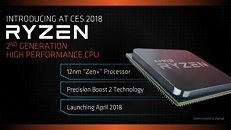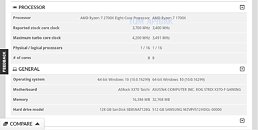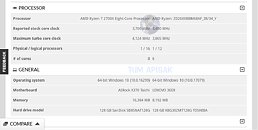Friday, March 2nd 2018

AMD Ryzen 7 2700X Spotted With a 3.7 GHz Base Clock, 4.1 GHz Turbo
AMD's next iteration on their very positively received Zen microarchitecture is preparing for take-off in the coming months, and as we draw ever close to the release date, more details are trickling in. This time, it's the appearance of a Ryzen 7 2700X (which supersedes the original Ryzen 7 1700X) on Futuremark's 3DMark database. The Ryzen 7 2700X was paired with an ASRock X370 Taichi motherboard (still considered one of the best ever to grace AMD's new AM4 platform), and its 8 cores and 16 threads are locked into a 3.7 GHz base and 4.1 GHz turbo clocks (respectively 300 MHz higher base and turbo clocks that the 1700X's).
The usage of AMD's XFR 2.0 (eXtended Frequency Range) and Precision Boost 2.0 could mean that the CPU is able, in certain scenarios, to turbo over the specified limit of 4.1 GHz, up to 4.2 GHz, thus delivering an even bigger boost to its performance. The usage of a 12 nm process means AMD has taken the power savings and increased frequency potential that comes from shrinking their original Zen microarchitecture, and put those to increased frequencies across the board, thus increasing their CPU's single-thread performance. Being an X chip,. AMD has kept the package TDP at a still respectable 95 W, much like its 1000 series Ryzens, though we know that this 95 W figure doesn't really spell out just how energy efficient these AMD CPUs really are.
Sources:
ComputerBase, WCCFTech
The usage of AMD's XFR 2.0 (eXtended Frequency Range) and Precision Boost 2.0 could mean that the CPU is able, in certain scenarios, to turbo over the specified limit of 4.1 GHz, up to 4.2 GHz, thus delivering an even bigger boost to its performance. The usage of a 12 nm process means AMD has taken the power savings and increased frequency potential that comes from shrinking their original Zen microarchitecture, and put those to increased frequencies across the board, thus increasing their CPU's single-thread performance. Being an X chip,. AMD has kept the package TDP at a still respectable 95 W, much like its 1000 series Ryzens, though we know that this 95 W figure doesn't really spell out just how energy efficient these AMD CPUs really are.




71 Comments on AMD Ryzen 7 2700X Spotted With a 3.7 GHz Base Clock, 4.1 GHz Turbo
I am very very interested in the Ryzen CPUs in general.. If the Ryzen 2's make a decent improvement on what's already here, I'm in!! :)
Also, what do you mean "XFR now works how it was supposed to"? You mean by clocking as high as thermals and the die allows within the power budget, with no fixed limit? I suppose that's what we all want, but that's not what AMD made it out to be initially, nor what it is so far. XFR and mXFR are quite different things simply because mXFR lives in the strictly power-limited mobile world, where the inherent clock limits of the chips don't matter much. I suppose we'll see what happens with these chips, but given the probability of relatively minor process improvements, I'm not betting on XFR 2 being an "auto overclock" any more than XFR was.
Also, I have to lend my support to the people here objecting to the notion of upgrading your CPU year-on-year (or generation-on-generation). I mean, even if you excrete money from various orifices, that's meaningless. Pay $300 or more every year for a <10% performance increase in CPU-bound tasks, and far, far less than that in everything else? Yeah, that's dumb alright. Unless you're running a workstation or datacenter where processing time is crucial for profits. I got a 1600X last year after holding on to my Q9450 for almost nine years. That's a bit long, but upgrading your CPU more frequently than every 3+ years? Waste of money.
Also, for mainstream chips, >100W TDPs are silly. ~90W strikes a perfect balance of reasonably easy to cool and power with cheap coolers and motherboards, and pushing that just makes you look bad - just look at the whole 125W (or more!) Bulldozer and onward. On the other hand, an 8700K can relatively easily be OC'd to >200W with the right motherboard. Having a process that scales well gives you certain freedoms, but pushing power at stock just makes you look like your base performance is sub-par.
I'm pretty sure every AM4 board except the cheapest are 125W capable and can be rated as such. We see people OCing hard on B350s. The only issue is VRM cooling on the cheapos, but the VRMs are stout enough. Any X370 will safely produce more power than necessary.
BTW, an increased AM4 TDP would also enable some very interesting products, like a 6-core and an 8-core Raven Ridge with the same 11CU iGPU. I wouldn't discount the possibility of such a product, considering the "fact" that an 8-core Coffee Lake is inbound later this year.
At 4.5 Ghz Ryzen's net performance will rival Intels latest, but the IPC doesnt change...
See: en.wikipedia.org/wiki/Coffee_Lake